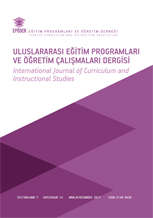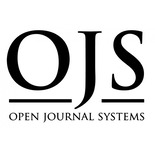An assessment of media literacy in Turkey
Abstract
The aim of this study is to analyze the contents of the articles on media literacy in Turkey and explore how media literacy is handled. The content of 66 articles in total, of which full texts could be obtained on the internet, were analyzed. Data obtained were interpreted based on percentage and frequency and presented in tables. Based on the data obtained, it was determined that the highest number of publications were in 2013. It was further determined that the subjects that were most studied on were the investigation of the practices in countries and inter-disciplinary works. It was established that document review was used as the principal data collection tool in the study where qualitative methods and research reviews were most common elements in publications. As for the sample level, it was observed that studies focus on primary school students and within a range of a sample of 101-300 people. It was determined that in data analysis, descriptive analysis is dominating and frequency percentage distribution is frequently used in the studies.
Downloads
References
Ashley, S., Poepsel, M. & Willis, E. (2010). Media literacy and news credibility: Does knowledge of media ownership increase skepticism in news consumers? The National Association for Media Literacy Education’s Journal of Media Literacy Education, 2(1), 37.
Asrak Hasdemir, T. (2009). Medya okuryazarlığı ve insan hakları: Türkiye örneği. Bulunduğu eser: Tüzün, G. (Ed.) Ders kitaplarında insan hakları II: Tarama sonuçları (ss.313-336). İstanbul: Tarih Vakfı Yayınları.
Baker, F. W. (2010). Media literacy: 21sy century literacy skills. In Jacobs, H. H. (Ed.) Curriculum 21 essential education for a changing world (ss.133-153). ASCD: Alexandria, Virginia USA.
Barnes, C., Brian, F., Corcoran, F. & O’Neill, B. (2007). Critical media literacy in Ireland. (Final Report). The Radharc Trust, Dublin.
Buckingham, D. (1998, Winter). Media education in the Uk: Moving beyond protectionism. Journal of communication, 48(1), 33-43. 10.06.2014 tarihinde http://namle.net/wpcontent/ uploads/2011/06/Buckingham_1998.pdf adresinden alınmıştır.
Cangin, S. Ş. (2014). İlköğretim öğrencilerinin medya okuryazarlığı dersine bakış açıları (Ankara – Keçiören örneği). Yayımlanmamış yüksek lisans tezi, Atatürk Üniversitesi, Erzurum.
Cohen, L., Manion, L. & Morrison, K. (2007). Research methods in education (6th ed.). New York, NY: Routledge.
Çakmak, E. (2010). İngiltere ve Türkiye’deki ilköğretim medya okuryazarlığı eğitimi program ve uygulamalarının karşılaştırmalı olarak incelenmesi. Yayımlanmamış doktora tezi, Abant İzzet Baysal
Üniversitesi, Bolu.
Domaille, K. & Buckingham, D. (2001). Youth media education survey 2001. (Final Report). London University, England.
Duncan, B. et al. (1989). Media literacy resource guide, Ontario Ministry of Education, Toronto, ON. Canada.
Fedorov, A. (2007). Media education: A historical perspective. Moscow: Ministry of Education and Science of the Russian Federation.
Fraenkel, J. R. & Wallen, N. E. (2003). How to design and evaluate research in education. McGraw-Hill, Boston, MA.
Görmez, E. (2014). Ortaokul öğrencilerinin medya okuryazarlığı düzeyleri. Yayımlanmamış doktora tezi, Atatürk Üniversitesi, Erzurum.
Grizzle, A. & Calvo M. C. T. (2013). Media and information literacy, policy and strategy guidelines. Retrieved June 20, 2014 from http://unesdoc.unesco.org/images/0022/002256/225606e.pdf.
Güneş, A. (2013). Medya pedagojisi. I. Türkiye Çocuk ve Medya Kongresi. (ss.83-99). İstanbul.
Heins, M. & Cho, C. (2003). Media literacy an alternative to censorship. Retrieved June 09, 2014 from http://www.fepproject.org/policyreports/medialiteracy.pdf.
Hobbs, R. (2004). Medya okuryazarlığı hareketinde yedi büyük tartışma (çev: Bağlı, M. Türkan), Ankara Üniversitesi Eğitim Bilimleri Fakültesi Dergisi, 37 (1), 122-140.
Jeong, S. H., Cho, H. & Hwang, Y. (2012). Media literacy interventions: a meta-analytic review. Journal of Communication, 62 (3), 454–472.
İnal, K. (2009). Medya okuryazarlığı el kitabı. Ankara: Ütopya Yayınevi.
Kellner, D. (1998). Multiple literacies and critical pedagogy in a multicultural society. Educational Theory, 48 (1), 103 –122.
Kellner, D. (2001). New technologies/new literacies: reconstructing education for the millennium.
International Journal of Technology and Design Education. 11, 67–81.
Kellner, D. & Share J. (2005). Toward critical media literacy: core concepts, debates, organizations,
and policy. Discourse: Studies in The Cultural Politics of Education, 26(3), 369-386.
Kress, G. (2003). Literacy in the new media age. London: Routledge.
Milli Eğitim Bakanlığı. (2007). İlköğretim medya okuryazarlığı dersi öğretim programı ve kılavuzu. 06.04.2014 tarihinde http://ttkb.meb.gov.tr/www/ogretim-programlari/icerik/72 adresinden alınmıştır.
Milli Eğitim Bakanlığı. (2013). Ortaokul ve imam hatip ortaokulu medya okuryazarlığı dersi öğretim programı. 14.03.2014 tarihinde http://ttkb.meb.gov.tr/dosyalar/programlar/ilkogretim/ medyaokuryazarligi_ortaokul.pdf adresinden alınmıştır.
Newby, P. (2010). Research methods for education. England: Pearson.
Miles, M. B. & Huberman, A. M. (1994). Qualitative data analysis: an expanded sourcebook. Calif.: Sage Publication
O’Neill, B. & Barnes, C. (2008). Media literacy and the public sphere: a contextual study for public media literacy promotion in Ireland. Retrieved June 20, 2013 from
http://www.dit.ie/cser/media/ditcser/images/Final%20Report%20BCI%20Media%20Literacy.pdf
Ofcom, (2014). Office of communication. Retrieved May 10, 2014 from http://stakeholders.ofcom.org.uk/marketdata- research/other/media-literacy/?a=0.
Özay, C. (2014). Ortaokul öğrencilerinin medya okuryazarlığına ilişkin görüşleri. Yayımlanmamış yüksek lisans tezi, Marmara Üniversitesi, İstanbul.
Penman, R. & Turnbull, S. (2007). Media literacy-concepts, research and regulatory issues. Retrieved June 20, 2013, from http://www.acma.gov.au/webwr/_assets/main/lib310665/media_literacy_report.pdf.
Potter, W. J. (2011). Media literacy (5. Ed.) London: Sage Publication.
Powell, R. M. (2014). Food for thought: a mixed methods media litearcy intervention on food marketing. A Dissertation Submitted to the Graduate Faculty of The University of Georgia in Partial Fulfillment of the Requirements for the Degree, Doctor Of Philosophy Athens, Georgia.
Schmidt, H. (2012). Media literacy education at the university level. The Journal of Effective Teaching, 12(1), 64-77.
Semiz, L. (2013). Ortaokul öğrencilerinin medya okuryazarlığı yeterlikleri ve medya okuryazarlığı dersini yürüten öğretmenlerin karşılaştıkları sorunlar. Yayımlanmamış yüksek lisans tezi, Recep Tayyip Erdoğan Üniversitesi, Rize.
Sözbilir, M., Kutu, H., & Yaşar, M. D. (2012). Science education research in Turkey: A content analysis of selected features of papers published. In J. Dillon & D. Jorde (Eds). The world of science education: handbook of research in europe (pp.341-374). Rotterdam: Sense Publishers.
Tan, O. (2015). Medya okuryazarlığı eğitimi: öğrenci, öğretmen, aile bağlamında örnek bir araştırma. Yayımlanmamış doktora tezi, Akdeniz Üniversitesi, Antalya.
Taşkıran Öncel, N. (2012). Medya okuryazarlığı: Avrupa profili. Kocaeli: Umuttepe Yayınları.
Thoman, E. (1999). Media literacy education can address the problem of media violence. In B. Leone (Ed.), Media violence: Opposing viewpoints, (pp.131–136). San Diego, CA: Greenhaven Press.
Thoman, E. & Jolls, T. (2003). Literacy for the 21st century, an overview & orientation guide to media literacy education. Retrieved June 20, 2014, from http://www.medialit.org/sites/default/files/mlk/01_MLKorientation.pdf.





